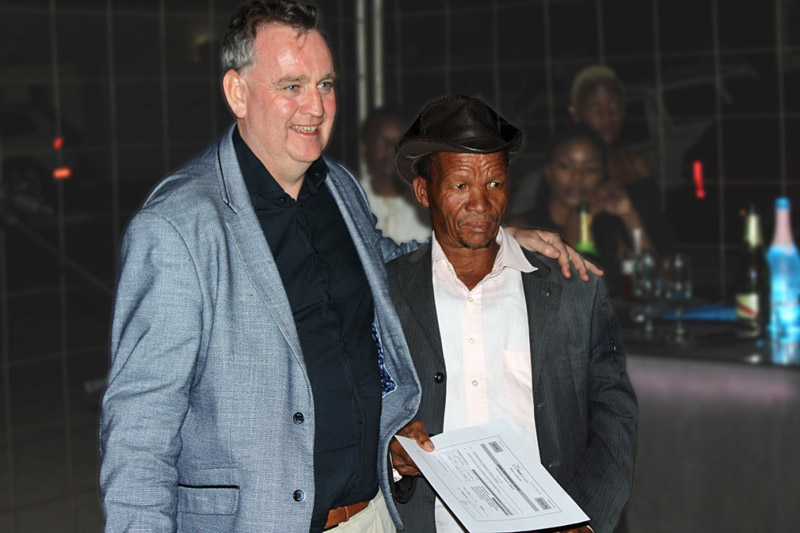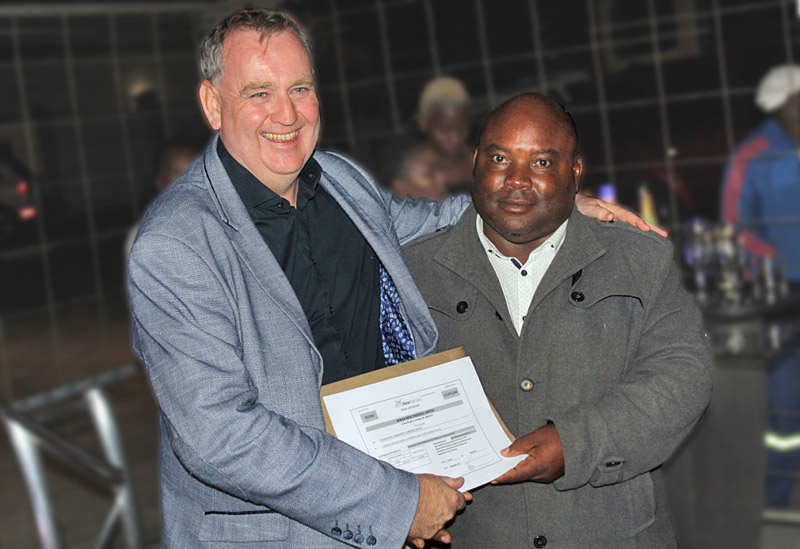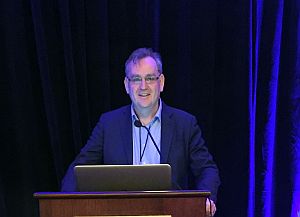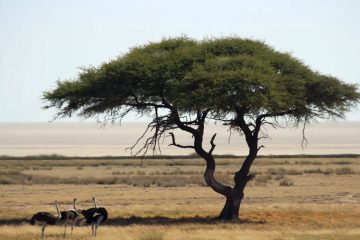San and Herero to benefit from direct community participation in oil & gas sector

Stephen Larkin with Chief Hendricks Martins of the San
Africa New Energies (ANE) has honoured a commitment to ensure that the indigenous San and Herero peoples living on its 22,000 square kilometre concession in eastern Namibia receive a material stake in the fortunes of the Africa-focused oil and gas exploration company.
During an auspicious ceremony held in the Namibian capital of Windhoek in May, ANE Chief Executive Officer Stephen Larkin formally handed over share certificates to representatives of the San and Herero, which will ultimately see 15% of ANE transferred to the host community.
ANE has created two United Kingdom-based organisations – charitable status pending at the time of writing – to look after the long-term interests of the people living on the concession, ensuring that they get access to healthcare, education and employment skills, while at the same time securing additional funding to help preserve their tradition, culture and way of life.
The trusts will also ensure that no fracking takes place on the concession, which hosts the world’s second largest aquifer on which 22,000 people living on the concession depend, while ensuring that the exploration and development of hydrocarbons has not impact on the environment.
Oil & gas discovery could be transformative
If ANE is successful in finding hydrocarbons on its concession, the San and the Herero can expect to benefit from Namibia’s resource wealth in much the same way as the Royal Bafokeng Nation of South Africa have benefitted from the mining of platinum under their land.
Over the past 15 years, 150,000 members of the Bafokeng living in 29 villages on 1,200 square kilometres of land in Northwest Province have seen their lives transformed as a result of the community’s 13.6% stake in Impala Platinum, South Africa’s second largest platinum miner.
Underneath the Bafokeng’s land lies part of the world’s largest platinum resource, owned by Impala, with an asset value of around some $4 billion. The Bafokeng’s minority stake in Impala – which is held in a trust on behalf of the entire Bafokeng nation – has seen more than $400 million spent on roads, schools, clinics and other public amenities.
In contrast to most other South African rural communities, 99% of households on Bafokeng land have access to potable water, and 96% of Bafokeng households have access to electricity.
The Bafokeng community development model is widely regarded as an example – par excellance – of how to manage host community relations, which ANE intends to emulate. While 60% of the taxes levied on hydrocarbon profits will go to central government, the remaining 40% will be earmarked for education, health and skills acquisition for the San and Herero.
Shareholder certificates presented to San and Herero
During the handover ceremony – in which Larkin presented shareholder certificates to Chief Hendrichs of the San, and xxx of the Herero – the ANE chief executive told the 100-strong audience that while black economic empowerment is not required in Namibia, ANE was eager to ensure that the 22,000 people living on the concession benefitted from its success.
“What made me so happy about this deal,” Larkin said “is that the community earned every share that we awarded them with their support in enabling us to secure the licence, and particularly by sharing their encyclopedic knowledge of the area that enabled our scientists to prove 731 oil and gas seeps across a region of almost two million acres.”
The shareholder ceremony is potentially transformative for the San and the Herero, and is in marked contrast to the troubled histories of the indigenous inhabitants of the south western region of the continent.

Stephen Larkin with Councillor Peter Kamunguizi Kazongomuinja representing the Aminuis Community
The San or Bushmen are the original indigenous people of the southern African region, and are scattered across Namibia, Botswana, Zimbabwe, Zambia, Lesotho and South Africa.
Known as the First People of the Kalahari (FPK), they are renowned for the profound connection they have with the land acquired over millennia – some estimates suggest they date back 100,000 years. San stone tools and rock art date back some 70,000 years – the oldest known art in the world.
The San were traditionally a semi-nomadic people, moving seasonally in search of water, game and edible plants. They lived in southern Africa long before the Bantu peoples migrated south, but came under pressure as a result of the migration, with many ending up as slaves or migrating to the drier regions of the Kalahari
Victims of extermination campaign
Early Boer settlers from the 17th century onwards launched an extermination campaign against the San – believing them to be little more than vermin – and are estimated to have killed more than 200,000 over two centuries. Today, some 60% of the San remaining live in Botswana, 35% in Namibia, with the rest scattered across the region.
Namibia’s Brandberg and Twyfelfontein are two areas rich in Bushman art, located in the Erongo region in the west of the country. According to one count, there are more than 50,000 examples of rock art in the Brandberg Mountains – mostly depicting warriors and wildlife.
The Herero, traditionally a pastoralist people who migrated to the region from West Africa centuries ago, came into conflict with German colonists from the late 19th century over land, water and the legal discrimination against the native population by white settlers.
During the notorious battle of Waterberg Plateau in 1904, German General Lothar von Trotha used belt-fed machine guns to mow down the indigenous people who were armed with little more than spears. Of the estimated 80,000 Herero living in the region when it became a German colony in 1884, only around 15,000 left when Germany was stripped of its colonies at the end of the First World War. Germany made a formal apology a century later.



0 Comments